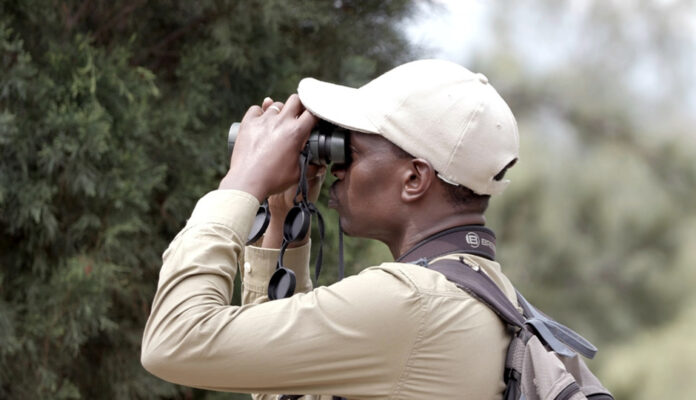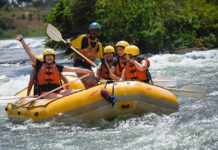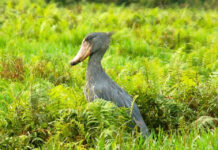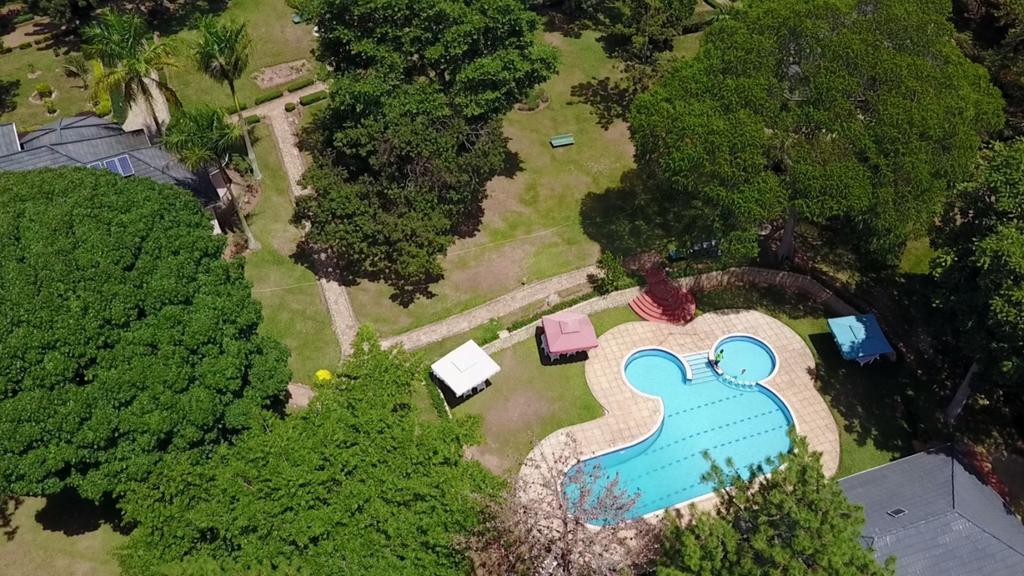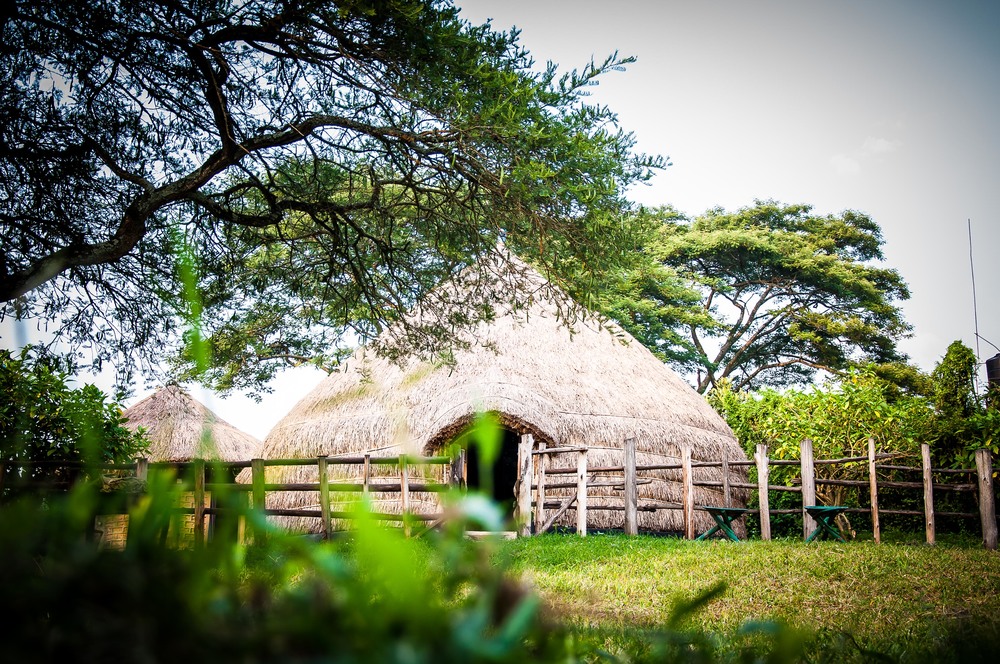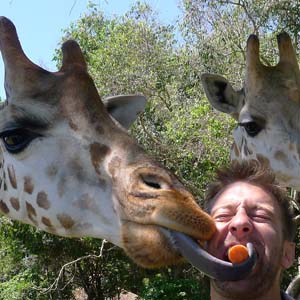Closer zoom: A tiny weaver bird dressed in eye-catchy yellow black feathers stands at the ring-like door of its half-finished nest which like that of his swam of twitting peers is hinged at one of the extreme branches of an avocado tree. On turning its neck leftwards, it is greeted with the worst news of the morning.
The girl of his dreams has moved in with his rival having been blown away by the fine finishing of his complex and elegant nest that boasts of captivating details, especially cobbled designs. Filled with fury and an unstoppable determination to try winning her back, he embarks on an aggressive mission to finish his nest ASAP. At once, he takes a quick dive onto the soft lawns at the foot of the avocado tree, pecks and picks a long grass straw using his round conical bill, and quickly dashes back to weave into its nest.
This was a live scene from Ngamba chimpanzee Sanctuary Island I witnessed on 19th January in company Lilly Ajoravo and Dr.Goodall Jane, the two powerhouse primatologists I look up to. While in the history calendar this was the day Goodall spent her 80th birthday with the 29 habituated chimpanzees of the pristine Island. In the adventure books, it’s the day she ranked it as the best chimpanzee sanctuary across the continent-after being blown away by the thoughtful manner in which the islands chimpanzee caregivers lovingly looked after the primates-like they were humans.
I won’t lie, like the birthday girl and the bunch of conservationists present, I had gone to the Island for a primate experience-however while the chimp experience story can wait, the birding experience cannot. Why? – Because it was a birdwatchers ‘dream come true with over 100 species that enchant all ones five senses using their spectacular beauty, a fascinating character, and positive attitude.
Accordingly, rather than stick to behavior observation of the chimps, I decided to get the best out of my short 24-hour visit to the bird paradise where birds enjoy unlimited freedom.
Unlike my preceding bird-watching treats in several national parks and forests where pre-recorded calls had to be made to attract the different species for observation, in Ngamba bird watching was hustle-free. Almost every corner was dotted with birds of different varieties, interests,s, and colors.
To get an up-close with those array of feathered indigenous and exotic species, all it took was an extra step into any turn along the paved paths and that’s exactly what I did-from the chimpanzee feeding arena-to the viewpoints under the scattered trees-all the way to its shores where sparsely populated trees were buttressed into the glistening bay. A bay that is laden with a singular cozy atmosphere is now lost in most of the surrounding islands as a result of uncontrolled environmental degradation.
First off was a pair of the Spur-winged plovers at the foot of a minor palm tree opposite the grass thatched diner. As expected, they deafened my eardrums with the sharp end of its kip-kip-kip threats purposely to frighten me away-thinking I was a predator. The closer my bare feet inched towards its territory, the more they became restless and started rioting all over the place whilst screaming sharper kip-kip-kip-kip-kip. At this point, Byron Semambo the Islands professional bird guide asked me to walk away or ready myself to pay the price. I wished I had listened otherwise my left heel wouldn’t have ended struck to bleeding.
Once at the shore adjacent to the fire assembly point, I caught up with a family of eight Egyptian geese cooling off the day’s steam with a good swim in the warm lake.
From a distance, they looked every bit like a goose but as they drew closer to the banks, it was actually a shelduck. It was a cross between a goose and a duck. Like a duck, it was equally a confused species of a big bird. At one point they would swim towards a particular direction only make a sudden U-turn before taking a short flight over to the shores, only to close their eyes before plummeting back to the water. According to Byron, they got their name- Egyptian goose because Egyptians domesticate them as they are considered sacred.
“In some parts of Roman, they are kept in domestic flocks.” The knowledgeable guide added
Going by their bright stunning plumage and dark chocolate-brown eye patches, only a fool could doubt that they looked beautiful too even when crying.
However, when it all seemed like the Egyptian goose was the most beautiful thing I had run into, my eyes landed on a dozen cross wire-tailed swallow perched along the wiring of a
fastened netball net. Precisely, the wire-tailed swallow is a small passerine bird with shiny blue above and white below with a neat chestnut cap. It is adored for the long thin wires of its white spotted-tailed plumage. Compared to the ban swallow, it had a rather subdued twittering which perhaps was too inaudible even for its own ears. Simply put, it was as beautiful as an Angolan swallow which was in plenty on the island, mainly hanging around building bars.
With all the above splendors and symphonies produced by the vast aviaries ringing in my head like a love song, it beat my brains out pondering why the island simply called a chimpanzee sanctuary as opposed to birding and
chimpanzee sanctuary or better still budding birding chimpanzee sanctuary. Tired of walking from one point to another, I sat back in front of my tent to behold the island’s picture perfect-postcard sunset views.
By this time, I had gotten an overdose of the unbeatable experience. I did not mind missing out on the nocturnal aviary experience. As I had requested, Byron brought me accompanying literature and wrote the list of 41 species I had seen by the end of the day. And that’s how my birding expedition would be crowned.


